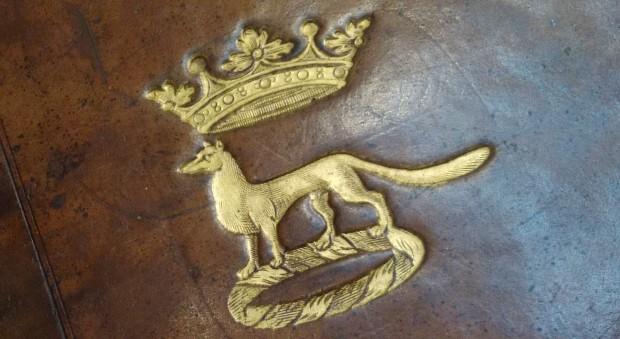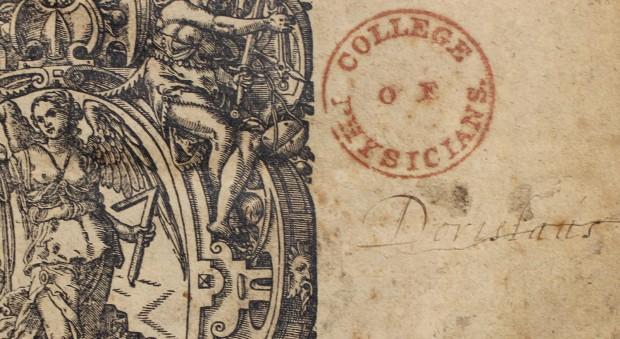In August 2017, librarianship student Catherine Chorley undertook a 2-week placement at the Royal College of Physicians (RCP) library, surveying our rare books for important marks of earlier ownership and use. In this post, she writes about her time here.
Rare books may be made more valuable to researchers when their provenance is more thoroughly recorded. Enriching catalogue records with information about past ownership (evidenced, for example, by book plates, library stamps, autographs and other manuscript annotations) or physical description is thus a fruitful but potentially time-consuming exercise. When collections are housed in areas not readily accessible for sustained research (particularly when that research necessitates the handling of rare books) it becomes a task not able to be undertaken as a matter of routine.
During August, the RCP museum is closed to the public so that important collections conservation and building maintenance work can be carried out. This year’s interstice afforded an opportunity to access one of the oldest collections, and the core around which the RCP library was replenished following the Great Fire in 1666. This collection of around 2,700 books is believed to be the bequest to the RCP by the family of Henry Pierrepont, Marquis of Dorchester in 1680.
This year’s interstice afforded an opportunity to access one of the oldest collections, and the core around which the RCP library was replenished following the Great Fire in 1666
My efforts in the main involved combing the collection book by book, noting each book’s Dorchester number, as well as any provenance information not already recorded on the electronic catalogue. New provenance information was also photographed for future reference, in case further evidence should emerge and clarify a previous record. Sometimes, an obscure-looking autograph or monogram in one book is replicated much more legibly elsewhere, or else a pattern of idiosyncratic annotations emerges, from which a reasonable inference regarding ownership can be made.

Provenance information may include the manner in which the book was bound or decorated, as styles prevailed or technologies changed. Another signifier of ownership is an armorial crest, often stamped on the binding; understandably, the Dorchester crest recurred throughout the fortnight, as did the RCP crest on books more recently rebound. Occasionally, ownership was marked with a lesser reverence for the physical object: one such example featured title-page doodles of a chicken, in imitation of the printer’s device.

Frustratingly, several texts were noteworthy for what they didn’t show: marks of bleaching where autographs and other provenance information had previously been were testament to prevailing attitudes of possessiveness, according to which a new owner would expunge all marks of previous ownership from history (much to our present-day chagrin).
One name to feature in many of the legal texts was that of (we believe) a seventeenth century Dutch legal advisor and later Regicide, Isaac Dorislaus. Dorislaus autographed his books most often alongside the printer’s device on the title page, and in the same distinct hand.

Other autographs were less penetrable, and remain sources for future provenance research. In either case, manuscript annotations frequently struck me as beautiful, irrespective of their semantic content. Perhaps it was the sense of history captured on the page, or amusement at seventeenth century scholars’ predilection for Latin graffiti.
During the second week of my placement, other members of the Library Services team visited the Dorchester Library to survey the work of conservators Caroline, Annie and Rita, who had been busily constructing bespoke ‘book shoes’ and shelf liners that support each book according to its individual specifications. Caroline demonstrated the utility of book shoes in countering the wear on books as they stand upright on the shelf. Book design, Caroline explained, is a legacy of their being stored horizontally. As books are now routinely stored upright, with the spines facing outwards to display the title or other identifying information, each book is constantly under the force of gravity in a direction which is not fully supported by its own structure. The book shoe structure mitigates against this strain by supporting the pages and allowing them to sit as intended in relation to the spine.
To illustrate the provenance research she and I were engaged in, Katie had also identified a selection of books that exhibited particularly notable features of books-binding techniques and ornamentation. As with most fields of scholarship and craftsmanship, there is an entire lexicon for book-binding and printing, so Katie’s ‘show and tell’ session provided a concise yet comprehensive overview of historical bibliography, and how many of the traditions of book-binding and printing are in evidence within the RCP’s rare book collections.
Working with rare books is always a rewarding experience. There is an endurance to these items that outstrips our fleeting curation of them. In delving in to the past, whether the past of the books themselves or the past practices of those responsible for their organisation and classification, we hope to make current and future use of these books not only possible, but also as rich as possible.
Catherine Chorley, library volunteer
Read our weekly library, archive and museum blog to learn more about the RCP’s collections, and follow @RCPmuseum on Twitter and @rcpmuseum on Instagram.
